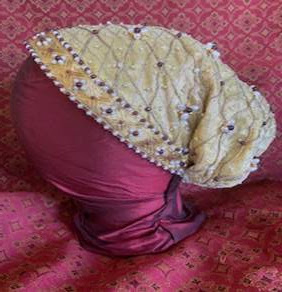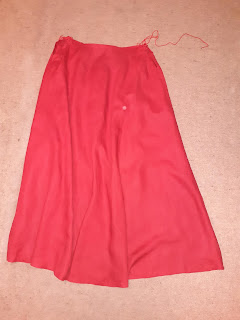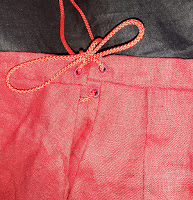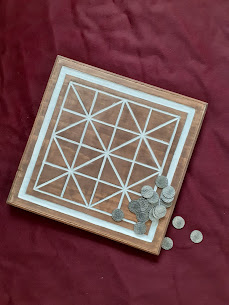The winning entry for the Arts and Sciences championship this year was a couple of delicious recipes from Portugal, submitted by the Honorable Lady Joana

She has kindly allowed us to publish her documentation, which can be found here.

The winning entry for the Arts and Sciences championship this year was a couple of delicious recipes from Portugal, submitted by the Honorable Lady Joana

She has kindly allowed us to publish her documentation, which can be found here.
Category: With silken coats, and caps, and golden rings, with ruffs, and cuffs, and farthingales, and things. A garment your persona may have worn.

Purpose:
I bought some beautiful red silk/wool blend and, as there are many red Portuguese dresses in the pictures of the 1520s, I thought that this was a good plan to keep up with the fashions! I also wanted to try something in keeping with the St Auta altarpiece dresses. I did not want to make one specific dress but incorporate a number of the features seen in this painting.

Materials used:
Method:
While my other Portuguese dress has a kirtle underneath I wanted this dress to be worn alone for my personal comfort. While many of the St Auta dresses appeared to open at the front, for aesthetic reasons I preferred to have the openings at the side back which can be seen in extant Italian gowns, especially Eleanor of Toledo’s. The Portuguese portrait of Queen Catherine as St Catherine is also clearly laced at the back and this dates from the late 1520s/early 1530s.
I used the pattern for my previous dress and cut out two front and back bodice pieces out of the cotton canvas as interlining. I then cut out the bodice in a piece of thin cotton batting. I zigzaged these three pieces together to make an inner support layer.
I cut out a bodice with seam allowance from the red silk and whip stitched this by hand over the canvas layer. I then whip stitched the cotton lining in place.
Angus put the eyelets in for me but I then couched over them by hand so they blended into the silk and for extra reinforcement.
I sewed the trim around the neckline. This trim placement can clearly be seen on the back of the beheaded lady in the red dress at the bottom of the St Auta altarpiece and on Queen Catherine’s dress. The trim matched the colour of the silk perfectly and while I can’t say it is specifically Portuguese it looks fabulous.
The skirt is four gored panels which are machine sewed together. This is then box pleated (by hand) to the bodice which is consistent with the Queen Catherine dress. I hemmed the skirt by machining wide cotton bias tape to the bottom. I then folded this inside the skirt and machined in place. I machined the trim on top of this on the outside of the skirt. This was because I was running short on time and even as I write this I have had to check multiple times how it was put together so it is not obvious.
I wanted to do sleeves like those on one of the St Auta side panels

These are fairly full with the opening down the back of the arm secured with ties. It is then tied
on to the bodice. I was fascinated that these sleeves and one in the centre of the 11000 Virgins painting appear to have a turned back cuff that has a wide fancy trim on it. The sleeves also appear to be lined in a different colour to the rest of the dress.
I found a beautiful gold/grey/green silk in my stash which worked beautifully with the silk and trim so I lined the sleeves in that.
On the turned back cuff I attached some wide gold-work style trim I found at Spotlight and attached the red/gold trim down the opening of the sleeves and used it on the bodice as loops to tie the sleeves to.
I cut a two inch strip out of the sleeve lining silk and then, by hand, whip stitched it closed. I cut this into lengths and attached an aglet to each end of these lengths to make ties. These I attached down the length of the sleeve opening when I attached the lining. I tied them together to make the sleeves. I made some others as ties at the top of the sleeve so it could be attached to the bodice.
I made a sash out of the same shot silk and put some of the wide trim (from the sleeve cuff) on the ends of it and added gold fringing.
Verdict:
I love this dress and enjoyed wearing it to the Spring Feast at Gildenwick. I think in the next version I will alter the cut of the sleeves slightly so the opening is more visible at the back of my arm and the cuff is more parallel to my wrist. I am enjoying my forays into Portuguese clothing as it is pretty and comfy! It worked well with my new Portuguese hat too!


Useful links:
Category: With scarfs, and fans, and double change of bravery, With amber bracelets, beads, and all this knavery. An accessory your persona may have owned, made, used, or gifted.

Purpose:
There are many hats in the Portuguese paintings of the 1520s, in particular they are seen all over the St Auta Altarpiece where many of the female figures are wearing a relation of a flat cap. The hat I particularly liked was in Gregorio Lopes’s Visitation painting as it was well blinged up! I had already made a version of the pink dress for the Baronial A&S Championship and made a version of the hat but it wasn’t quite right so I wanted to make one that was more in keeping with the portrait. I spent a long time staring at the image to get a sense of what was happening with this hat and talked to Mistresses Isabel Maria and Cristia about it. The consensus was that it was a kind of split brim arrangement that was sewed up on to the side of the hat. Much paper was used to get a sense of how it worked.

Materials used:
Methods used:



Verdict:
It is so pretty and much more in keeping with the portrait than my first attempt. I didn’t count on there being so much bulk inside the hat with the edges of the panels sewing into it so it doesn’t fit quite as comfortably as I would prefer but it still works.
Additional images
Category: An accessory your persona may have owned, made, used, or gifted. “With scarfs, and fans, and double change of bravery, With amber bracelets, beads, and all this knavery.”

Persona period inspiration and use:
Goldhaubes were the coifs / “hairnets” worn by women of the 16th C Saxon court. The dowry of Magdalene of Saxony lists a number of haubes, most with pearls and some with metal ornaments, or spangles. At least one of these haubes was noted as having been made by Magdalene’s mother, the Duchess, so this could be a project that a noble woman might make for herself or for a family member or friend.Christian is not fond of hats and headwear, but finds these haubes are generally the least annoying appropriate hair covering.
This haube is intended to match an under-construction red velvet gown with guards of yellow and white silk brocade.
Design, Materials and Construction:
These haubes were variously constructed, some appear to be made from embroidered or patterned fabric, some from cords knotted or constructed into a net; illustrations suggest that these were less likely to be made using more traditional hair-netting techniques like sprang, however men in this period wore “hairnets” which do seem to be made more often in those techniques. Haubes were usually made of gold cords and/or narrow wares, or gold fabrics, often patterned in black; and were usually embellished with pearls, spangles and other ornaments.
Materials: gold metal-thread net fabric, lined with silk, pearls of two colours, garnets, metal thread, and gold cord. The haube is lined with fine bright yellow silk to both ensure the haube more closely tones with the brocade of the gown’s brocade, and to hide “fake” hair used to imitate haristyles of the period.
Construction: the fabric was embellished with pearls, cords, and semiprecious stones; lined with silk, and attached to a decorative band also decorated with pearls and garnets.
Reference:
Category: With silken coats, and caps, and golden rings, with ruffs, and cuffs, and farthingales and things. A garment your persona may have worn.

Inspiration:
Both versions of Juan de Alcega’s Libro de Geometria, Pratica, y Traca (1580 and 1589) contain several cutting diagrams for vasquinas, which I interpret to be a skirt that can be worn as an underlayer (ie a petticoat), or as an outer layer for non-court styles.
As I am refreshing my camping wardrobe, and want clothing that will be wearable at increasingly warm Canterbury Faires, I chose to make a linen version of this garment to complement my existing woolen skirts.
Pattern
Alcega has numerous cutting diagrams showing the most efficient way to cut this garment out of different widths of fabric, for example:

Construction
I adapted the pattern from Alecga and constructed it using machine sewing for the initial long construction seams, and hand sewing for finishing the seams, hem, waistband, and eyelets.

The back is pleated, using knife pleats, into the waistband, while the front is kept mostly flat, for a flattering line over the stomach. To allow for maximum flexibility of use (and to fit pockets conveniently underneath), I chose to have dual side openings closed with a lace threaded through eyelets.

Verdict
It is lovely having another linen skirt to wear in warm weather. Additionally, the dual openings allow access to multiple pockets, but also permit adjustment to suit both what I am wearing, and body fluctuations.
However, I do think it is a bit plain and intend to add multiple stripes of a different red fabric around the hem.
Resources
Isabel Maria shares her black linen voile manto, in the category “with scarfs and fans and double change of bravery With amber bracelets bead and all this knavery” as an example of an accessory her persona would have owned and used.

“Both versions of Juan de Alcega’s Libro de Geometria, Pratica, y Traca (1580 and 1589) contain several cutting diagrams for a garment called a manto. Alcega suggests that such a garment be made of anascote, seda or clarisea. He also states that the appropriate length is from top of the head to the ankle. This would appear to suggest it is some kind of all-encompassing veil or modesty wrap. At this point I asked “how and when was this garment worn in period?”.
Marcelin Defourneaux, in Daily Life in Spain in the Golden Age, describes the wearing of the tapados (or veils) as “cloaks which completely covered them and which were pulled down over their faces, allowing only one eye to peep out.” He later quotes the Council of Castille saying (during the reign of Philip II) “The custom of women to o veiled has become so excessive that it is now prejudicial to the best interest of the state, for, because of this fashion a father no longer recognises his daughter, not a husband his wife…” and states that Philip II forbade its use, but without success. Similarly, he quotes a contemporary writer railing against the practice of folding, and refolding the veil to hide all but the left eye describing it as “a lacivious thing”.
This sounds exactly like the kind of garment any fashionable lady simply must have in her wardrobe.
Pattern
Alcega has numerous cutting diagrams showing the most efficient way to cut this garment out of different types and widths of fabric, for example:

Construction
Rather than piecing the garment as shown in Alcega, I was able to cut it out of one length, as my linen voile was sufficiently wide, unlike period fabrics. I hand stitched a narrow rolled hem around the whole piece and then added a narrow black lace to the hem based on a 1590 image found on Indumentaria y Costumbres en Espana. While the edging adds interest to the garment, it also makes it easier to control the fabric, as it is a simple matter to tell if you are gripping the edge you want, or something else.
Sadly, I haven’t been able to get a picture of me wearing the manto, but here is an image of the finished item.

Verdict
This is a pretty and thoroughly inconvenient garment to wear, but perhaps that will change with practice?
Resources
Category: A garment your persona may have worn. “With silken coats, and caps, and golden rings, with ruffs, and cuffs, and farthingales, and things.”

Persona period inspiration and use:
Christian has an alter ego as the wife of a Landsknecht (German mercenary soldiers, late 15th and 16th-century). The making of personal linens for the family was traditionally a task for the woman of the household.
This shirt was undertaken as a project to while away lockdown. The shirt needs to be suitable for camping at Canterbury Faire; e.g. a high neck to protect against the sun, and minimal embellishments (e.g. embroidery) in order to be easily and repeatedly laundered.
Design, Materials and Construction:
There are no landsknecht extant shirts from this period, so the design, materials, construction, and fastening systems had to be extrapolated from extant German shirts from the late 15thC, a German child’s shirt from the early 16thC, and other men’s shirts from the early, mid, and late 16th C.
There are hundreds, perhaps thousands, of representations of landsknechts shirts in prints from the period. These images show a variety of possible shirt styles and designs (in terms of cut, fastening, embellishments etc), and details can be filled in from extant garments and images of the shirts of elite men e.g. Matthaeus Schwarz.
The linen fabric of this shirt is coarser than the fine linen that would have been used for an elite shirt. The shirt was hand sewn with linen thread; following the construction of some extent garments, the main construction seams were sewn in thicker linen thread and the finishing / detail work in finer thread.
Given lockdown resources, I had to use linen fabric ties for the neck and cuff fastenings, but these actually worked out better than expected.
Reference:
Isabel Maria shares project for the category of “what revels are in hand? Is there no play, To ease the anguish of a torturing hour?”

Purpose
Despite having a good selection of SCA period games, I really wanted some more specifically Spanish games to add to my repertoire. It became necessary to do some research to find quintessentially Spanish games. Early on I learned about the different styles of playing cards, and eventually managed to acquire a modern set of them, but that was not enough. So I asked “what board games were played in 16th Century Aragon, Catalan or even Portugal?”
These questions lead me to the game of Alquerque. We have proof of it being played in the 13th Century, but things get rather more sparse thereon out. However, it is generally accepted as having been introduced to the New World, where it was promptly adapted to suit the locals tastes, creating the game of kolowis awithlaknannai. With that in mind, it seems reasonable that it would still be known in Spain during the waning years of the 16th Century.
Construction & Shopping
Simple, solid pine board stained to make it look like more expensive wood, and mimic period board games. The geometric design was carefully measured out before being drawn on in pencil and carved out. The carved design was then painted with gesso in preparation for painting. In order to satisfy Isabel María’s preferences for surface ornamentation, additional decorations will be taken from a variety of 16th century game boards and combined before being added to the carved areas of the game board.
The game requires 12 counters for each player. I play the game with 24 pewter jettons (12 portcullis side up and the other 12 with the jester up) until I find some better tokens.
Verdict
A fun wee game that can tax the brain after a hard days camping. Goes well with a light Spanish wine and small quantities of consequence free gambling.
Category: An item of food or drink your persona may have grown, prepared, consumed, or known of. Do you think because you are virtuous, that there shall be no more cakes and ale?
Persona period inspiration and use:
Design, Materials and Construction:
Recipe: Sabina Welser has a recipe (number 14) in which apples are sliced, “floated” in fat until brown, layered in a pie with spices and raisins, and baked with a crust on top. For the convenience of the picnic, I was making small individual pies, which made layering fiddly, so I choose a simpler recipe described by Bach as “chopped apples, precooked in fat with raisins, sugar, fat, and cinnamon”. I chopped some apples and, along with some raisins, sautéed these gently in butter (my preferred choice of fat for a vegetarian friendly pie), and mixed in sugar and cinnamon to taste. This was baked in a pie with a double (top and bottom) crust.
I completely forgot to take a photograph of these pies (although they did look just like the Genovese Tarts). They were delicious.
Reference:
Category: An item of food or drink your persona may have grown, prepared, consumed, or known of. “Do you think because you are virtuous, that there shall be no more cakes and ale?”

Persona period inspiration and use:
This recipe comes from Sabina Welserin’s cookbook, Das Kochbuch der Sabina Welserin (1553). The Welser were international mercantile bankers and venture capitalists, members, with the Fugger and the Hochstetter families, of the mercantile patriciate of Augsburg. These recipes, compiled for a rich urban German household, seem suitable for a noble Saxon women like Christian, although she probably would not have baked them herself. The recipe collection was not originally intended for publication or circulation; it may have been possibly written by the Sabina herself, but was more probably written by her kitchen professionals on her behalf.
I made these pies to take for a picnic lunch at an event; they are ideal for this purpose as they taste good hot or cold, and (as the pies have a top crust) they travel well. For picnics I tend to make small finger-food-sized pies for convenience, but when cooking a feast these pies work equally well as individual or ‘family’ sized pies. They are a good protein dish for vegetarians, and also a useful pie for those who don’t eat eggs.
Design, Materials and Construction:
Reference: